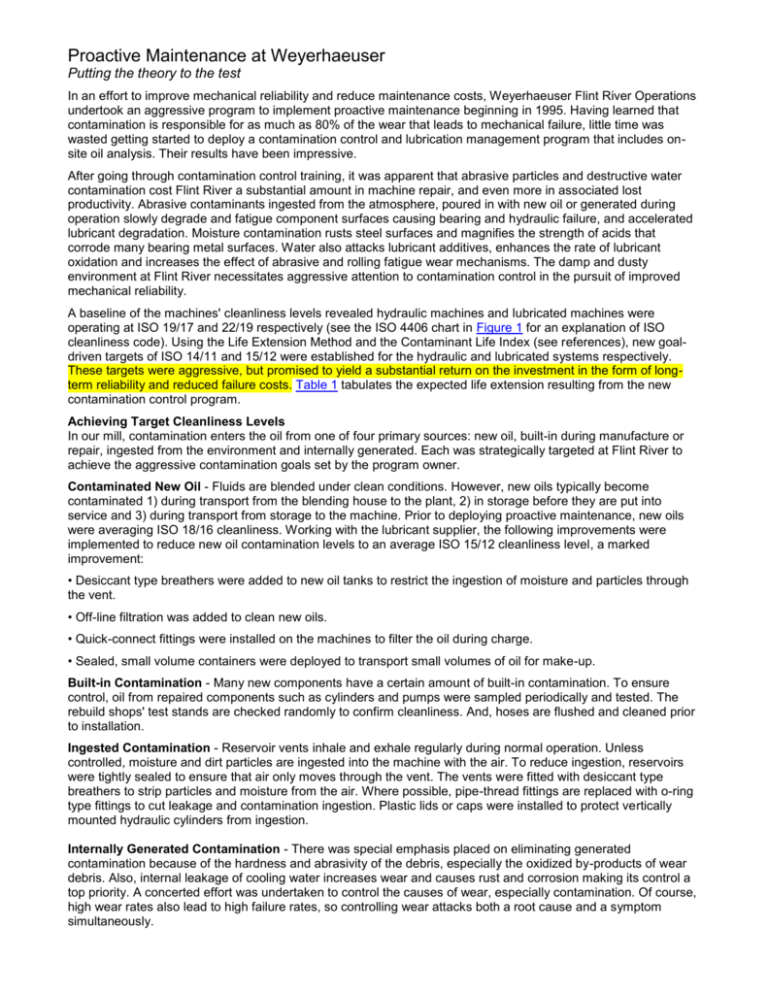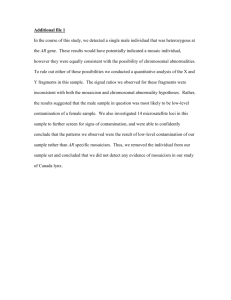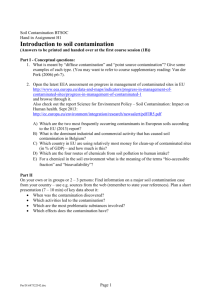Proactive Maintenance at Weyerhaeuser
advertisement

Proactive Maintenance at Weyerhaeuser Putting the theory to the test In an effort to improve mechanical reliability and reduce maintenance costs, Weyerhaeuser Flint River Operations undertook an aggressive program to implement proactive maintenance beginning in 1995. Having learned that contamination is responsible for as much as 80% of the wear that leads to mechanical failure, little time was wasted getting started to deploy a contamination control and lubrication management program that includes onsite oil analysis. Their results have been impressive. After going through contamination control training, it was apparent that abrasive particles and destructive water contamination cost Flint River a substantial amount in machine repair, and even more in associated lost productivity. Abrasive contaminants ingested from the atmosphere, poured in with new oil or generated during operation slowly degrade and fatigue component surfaces causing bearing and hydraulic failure, and accelerated lubricant degradation. Moisture contamination rusts steel surfaces and magnifies the strength of acids that corrode many bearing metal surfaces. Water also attacks lubricant additives, enhances the rate of lubricant oxidation and increases the effect of abrasive and rolling fatigue wear mechanisms. The damp and dusty environment at Flint River necessitates aggressive attention to contamination control in the pursuit of improved mechanical reliability. A baseline of the machines' cleanliness levels revealed hydraulic machines and lubricated machines were operating at ISO 19/17 and 22/19 respectively (see the ISO 4406 chart in Figure 1 for an explanation of ISO cleanliness code). Using the Life Extension Method and the Contaminant Life Index (see references), new goaldriven targets of ISO 14/11 and 15/12 were established for the hydraulic and lubricated systems respectively. These targets were aggressive, but promised to yield a substantial return on the investment in the form of longterm reliability and reduced failure costs. Table 1 tabulates the expected life extension resulting from the new contamination control program. Achieving Target Cleanliness Levels In our mill, contamination enters the oil from one of four primary sources: new oil, built-in during manufacture or repair, ingested from the environment and internally generated. Each was strategically targeted at Flint River to achieve the aggressive contamination goals set by the program owner. Contaminated New Oil - Fluids are blended under clean conditions. However, new oils typically become contaminated 1) during transport from the blending house to the plant, 2) in storage before they are put into service and 3) during transport from storage to the machine. Prior to deploying proactive maintenance, new oils were averaging ISO 18/16 cleanliness. Working with the lubricant supplier, the following improvements were implemented to reduce new oil contamination levels to an average ISO 15/12 cleanliness level, a marked improvement: • Desiccant type breathers were added to new oil tanks to restrict the ingestion of moisture and particles through the vent. • Off-line filtration was added to clean new oils. • Quick-connect fittings were installed on the machines to filter the oil during charge. • Sealed, small volume containers were deployed to transport small volumes of oil for make-up. Built-in Contamination - Many new components have a certain amount of built-in contamination. To ensure control, oil from repaired components such as cylinders and pumps were sampled periodically and tested. The rebuild shops' test stands are checked randomly to confirm cleanliness. And, hoses are flushed and cleaned prior to installation. Ingested Contamination - Reservoir vents inhale and exhale regularly during normal operation. Unless controlled, moisture and dirt particles are ingested into the machine with the air. To reduce ingestion, reservoirs were tightly sealed to ensure that air only moves through the vent. The vents were fitted with desiccant type breathers to strip particles and moisture from the air. Where possible, pipe-thread fittings are replaced with o-ring type fittings to cut leakage and contamination ingestion. Plastic lids or caps were installed to protect vertically mounted hydraulic cylinders from ingestion. Internally Generated Contamination - There was special emphasis placed on eliminating generated contamination because of the hardness and abrasivity of the debris, especially the oxidized by-products of wear debris. Also, internal leakage of cooling water increases wear and causes rust and corrosion making its control a top priority. A concerted effort was undertaken to control the causes of wear, especially contamination. Of course, high wear rates also lead to high failure rates, so controlling wear attacks both a root cause and a symptom simultaneously. Once contamination ingress was under control, the Flint River staff began to upgrade elements on the systems already outfitted with filtration, add off-line filtration to systems where full-time contamination control is cost justified and deploy portable filtration carts for periodic off-line clean-up of other systems. Between the aggressive efforts to exclude and remove contamination, cleanliness targets have been met. Oil Analysis at Flint River Oil analysis is central to the maintenance process at Flint River. It drives the following maintenance decisions and actions: Uncovers non-conforming contaminant levels and schedules appropriate work- orders, such as filter changes, use of portable filtration, seal replacement, etc., to restore normal contamination levels. Detects abnormal wear and determines the root cause. If one fails to discover and correct the root cause, the situation is likely to reoccur. Identifies degraded lubricants, deter- mines the cause for the degradation (if abnormal) and schedules a change or any other appropriate corrective actions. Most routine oil analysis is performed on-site by the program owner at Flint River. On-site analysis enables immediate follow-up and correction of the abnormal condition, avoiding time delays often associated with outside oil analysis. Simple testing, including particle counting, moisture testing, viscometry and some microscopic analysis, is performed on-site. More extensive testing like elemental spectroscopy, total acid number (TAN), etc., however, is reserved for the outside laboratory. Here is how the program works: Bottle samples are drawn from new oils, centrifugal pump lubes, gear reducer oils and other lubricating oils. To ensure that the sample is representative of the in-service oil that lubricates the components, a substantial volume is flushed prior to taking the sample. Samples are assembled at a central shop-level testing location for analysis. Prior to analysis, the samples are agitated with a paint-shaker to evenly suspend the particles in the oil. Equipment routes are downloaded to the test instrument from the host oil analysis information management software prior to testing. Particle count is performed to determine the ISO cleanliness level. Viscosity testing is performed to identify wrong or degraded lubricant. If the particle count is high, a ferrous particle count is performed to deter- mine if the debris is dirt or ferrous wear particles. Samples are screened for moisture using a crackle test and a percent saturation meter. Samples that indicate an alarm are turned on end to allow the particles to settle. The particles are then deposited onto a patch for viewing under a microscope. After completion of the route, the data is uploaded to the oil analysis information management software for storage and trending. Certain oils, especially those with exception conditions, are sent to an off-site oil analysis laboratory for more extensive testing. Program Management Proactive maintenance at Flint River is carried out by a single program owner who serves as the champion for excellence in lubrication management and oil analysis. The owner is responsible for all aspects of proactive maintenance, including the following: Selects proper location for and installs sampling ports and valves. Establishes targets and alarm levels. Coordinates with the lubricant supplier to ensure new oil quality. Samples systems routinely. Performs on-site oil analysis. Deploys contamination control improvements. Manages samples analyzed at an off-site laboratory. Manages oil analysis information system. Tracks program performance. Helps area owners solve problems. Benefits of Proactive Maintenance While numerous benefits have been realized at Flint River since implementing proactive maintenance, improved uptime tops the list. By reducing contamination, downtime has been reduced by 90%. Figure 2 charts the reduction in downtime (hours per month on a six-month moving average and least-squares regression line) caused by hydraulic unreliability. As can be seen on the graph, it takes some time for the benefits of a proactive maintenance program to be realized. Proactive maintenance is a lifestyle change that affects mechanical reliability on a go-forward basis only once the improvements are implemented; it can not restore damage already done to the system. Also, it takes time to uncover contamination control problems, identify their sources, select the best corrective actions, implement the corrective actions and realize the associated benefits. Starting in August, 1997, the downtime hours attributable to hydraulic failures really began to push down as is expressed by the six month moving average. Also, the variation in downtime hours reduced substantially. Low variation suggests effective control. Figure 3 shows the comparison on the average and standard deviation for the downtime caused by hydraulic failures during the first year of proactive maintenance program to the performance over the past year (1998). Clearly the 90% downtime reduction is significant. Also significant is the reduced standard deviation for downtime in 1998 versus the first year of the program. A controlled process should have an acceptable average and a small variation. Significant strides have been made on both counts since implementing proactive maintenance at Flint River. Another important consideration is the worst case scenario for downtime. Production planners and managers must prepare for the worst case to occur. By implementing proactive maintenance, the worst case scenario for downtime caused by hydraulic systems has dropped from almost 14 hours/month to just over 3 hours/month (assuming a 95% confidence level), a marked improvement (see Figure 3). This kind of information is critical to making effective sales and purchasing decisions. In addition to reducing downtime, repair costs have been reduced by 74% with the deployment of proactive maintenance (Table 2 summarizes the achievements from proactive maintenance at Flint River). When a dollar in maintenance costs is avoided, that money goes directly to the operating profit line since there is no cost of goods sold associated with the improved revenue. That makes the repair cost reductions especially important to overall profitability. Since cost reductions and production improvements occur simultaneously, proactive maintenance pays both coming and going at Flint River. The organization has embraced proactive maintenance. Overall awareness of cleanliness procedures and proper lubrication has improved throughout the organization, and the maintenance team really appreciates the proactive approach versus reacting to problems that are both expensive and stressful. Management is highly supportive of corporate-wide efforts to improve equipment reliability through lubrication best-practice standardization. Conclusion Proactive maintenance has really delivered at Weyerhaeuser's Flint River facility. Machines are running clean, dry and well lubricated. This change has yielded substantial improvements that positively affect the company's bottom line. As for the future, the program is being institutionalized through Weyerhaeuser's lubrication best-practices documentation process. They will continue to expand proactive maintenance until it is no longer cost effective to do so. A special focus is presently directed toward the integration of oil analysis, vibration analysis and the other condition monitoring techniques. Integrated condition monitoring yields educated decisions, precision control over the root causes of machine failure, optimized reliability and maximized profits. These efforts will help to ensure that Flint River remains competitive and profitable. References: 1. Fitch, J.C. (1986) "Quantifying the Contaminant Tolerance of Hydraulic Systems Using the Contaminant Life Index," NCFP, May. 2. Troyer, Drew D. and James C. Fitch (1995) "An Introduction to Fluid Contamination Analysis," P/PM Technology, June. Table 1 Figure 2 Table 2






